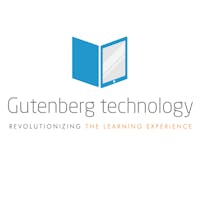In 1455, Johannes Gutenberg did what no one had done before. He printed the first major book, using movable metal type. Books became the gold standard of information storage because they could finally be easily reproduced and shared. From that day forward, the printed book became the foundation of the educational publishing industry.
Those days are coming to an end. The rising cost of printed textbooks—as well as tuition and university life—have made them unaffordable for many students. As a result, more students are turning to used books, rentals, shared copies, illegal downloads, and other online sources. As the financial viability of printed textbooks declines little by little, the demand for alternatives like online learning content continues to grow. In order to succeed in a rapidly changing market, educators, students, and publishers need to evolve. Digital learning platforms are not, however, simply a matter of reproducing a print-first approach via high fidelity ebooks. Instead, new technologies allow publishers to reuse, remix and repurpose any content element into curated learning objects, which can be searchable and delivered as digital content “bundles”.
The Benefits of Digital Learning
Digital learning has become the fastest growing field in academic publishing. And affordability is only one factor. Going digital offers students other benefits, including:
- Portability—Numerous courses or books can be stored on a single device.
- Flexibility—Material can be accessed anytime, anywhere.
- Stress-free self assessments—Students can easily track their own progress on the go.
- Personalized learning—If students need extra practice in certain subjects, they can access additional study guides and review tools.
- Interactive activities—Online learning often incorporates interactive demonstrations and multimedia elements.
- Quick access to additional resources—Supplemental material and class discussion boards are only a click away.
Instructors of online and blended learning programs also reap the benefits. A recent Deloitte study found that digital content in a blended or flipped classroom allows for improved class management, more personalized learning for struggling students, and an increase in student engagement and grades.
Reusable Objects Simplify Publishing
When a printed textbook becomes out of date, the remedy is an expensive and time-consuming revision process. In digital publishing, however, content can be reused, revised, and repurposed as often as needed. The easiest way to achieve this is through the use of reusable learning objects (RLOs).
An RLO, simply put, is a bite-sized segment of relevant content—articles, videos, pictures, and sections of books, etc.—that is searchable, adaptable, and easily repurposed. These small chunks of information are concise and targeted to meet any learning objective imaginable.
Paul Belfanti, a content management strategist who’s worked with both Pearson Education and Ascend Learning, explains:
Richly tagged learning objects, matched with learning objectives and skills, will be key to shifting from print-centric offerings to dynamic and engaging learning ecosystems. These kinds of systems drive adaptive, personalized learning environments and improved learner outcomes. Those same learning objects will enable content developers to efficiently find, curate, modify, combine and package chunks of content for any format or platform—digital or print.
How are RLOs used? All good reusable learning objects have a few important aspects in common. They are:
- Tagged with meta-data—For RLOs to be useful, they must be indexed properly with meta-data. This can refer to grade, subject, topic, level of competency, sets of skills, and even state standards. Publishers and educators can easily find previously created learning objects and use them in new projects or courseware.
- Customizable—To be truly reusable, learning objects also must be customizable. These learning objects can be used independently or aggregated as customized courseware.
- Concise—Each learning object should offer short bursts of learning, such as videos, interactive materials, and assessments. These self-contained activities can be completed in less than fifteen minutes and can be connected to form a complete, themed lesson.
When put to best use, reusable learning elements can free up subject matter experts in publishing and higher education—as well as all educators—to work toward increasingly innovative learning solutions.
Create Courseware Using Learning Objects
By tagging all learning objects with appropriate metadata, everyone benefits. Not only can publishers easily find content—so can students and educators. The course creation options available are almost endless; below are a few of the most powerful trends gaining traction:
- Microlearning—Learning objects make it easy for students to learn in short study sessions. It’s not just convenient, it’s also effective. Studies have shown that students who break up study time throughout the day score higher on graded assessments and retain information long after the class has ended.
- Personalized Learning—With an increasing number of students juggling classes with employment, personalized learning is a game changer. By allowing students the option to study where, when, and how they want, publishers and educational institutions can collaborate to help students thrive.
- Affordable Content Subscriptions—Learning programs are finally catching up with our 21st-century technological boom, so why don’t the payment options match? Some companies have elected to offer new subscription options much like Netflix, Hulu, and Spotify. Rather than paying hundreds up front for a new textbook, students can now pay for an affordable digital learning subscription!
Digital First is Leading the Way
As digital learning continues to grow in popularity, we must be innovative, efficient, and cutting-edge. Big-names in publishing, including Cengage Learning, are taking a digital first approach to content creation. Rather than creating print-centric content and forcing it into a digital format, the digital first method concurrently focuses on both the content and its expression on a digital platform—while allowing the same underlying content to be delivered for simultaneous print production.
The authoring tool MyEcontentFactory allows for digital textbooks to be created at the same time as the printed textbook, saving time and money. Gutenberg Technology (GT) CEO Gjergj Demiraj believes that the adoption of authoring and learning content management tools is often undermined and delayed because it represents a financial and organizational investment that can stretch over two years. "This tactical approach allows for short-term savings," he says, "but slows down the overall capability of the organization to respond to market demands.”
Running a successful academic publishing company is more challenging than ever. Its continued viability is contingent on the reinvention of the traditional business model to encompass the exploration of digital learning, customized learning experiences, and an updated pricing and purchase model. Most importantly, it depends on the drive and ingenuity of publishers to continue pushing the industry to better serve students and educators.
Gutenberg Technology’s new courseware creator is a digital solution for exploring this new era of academic publishing. The features available within GT’s authoring tool, MyEcontentFactory, allow content creators to transform chunks of text, media, and assessments into learning objects; meta-tag them; and reuse them in personalized learning environments. This functionality includes an impressive range of state-of-the-art content creation tools to help publishers break into the new world of digital publishing and become the Netflix of Publishing.



